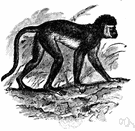guenon
(redirected from guenons)Also found in: Thesaurus, Encyclopedia.
gue·non
(gə-nōn′)n.
Any of various small- to medium-sized African monkeys primarily of the tribe Cercopithecini, being chiefly arboreal and having long hind legs, a long tail, and often a brightly colored face.
[French : from guen-, as in guenilles, filthy clothing, and earlier guenipe, dirty scrap of cloth (in reference to the guenon's tail, which trails like the train of a gown ), ultimately from French dialectal guener, to dirty, moisten; akin to French dialectal gasne, stagnant pool, slough, perhaps of Gaulish origin.]
American Heritage® Dictionary of the English Language, Fifth Edition. Copyright © 2016 by Houghton Mifflin Harcourt Publishing Company. Published by Houghton Mifflin Harcourt Publishing Company. All rights reserved.
guenon
(ɡəˈnɒn)n
(Animals) any slender agile Old World monkey of the genus Cercopithecus, inhabiting wooded regions of Africa and having long hind limbs and tail and long hair surrounding the face
[C19: from French, of unknown origin]
Collins English Dictionary – Complete and Unabridged, 12th Edition 2014 © HarperCollins Publishers 1991, 1994, 1998, 2000, 2003, 2006, 2007, 2009, 2011, 2014
gue•non
(gəˈnɔ̃, -ˈnɒn)n.
any long-tailed African monkey of the genus Cercopithecus, as the vervet.
[1830–40; < French (of uncertain orig.)]
Random House Kernerman Webster's College Dictionary, © 2010 K Dictionaries Ltd. Copyright 2005, 1997, 1991 by Random House, Inc. All rights reserved.
ThesaurusAntonymsRelated WordsSynonymsLegend:
Switch to new thesaurus
| Noun | 1. |  guenon - small slender African monkey having long hind limbs and tail and long hair around the face guenon - small slender African monkey having long hind limbs and tail and long hair around the facecatarrhine, Old World monkey - of Africa or Arabia or Asia; having nonprehensile tails and nostrils close together Cercopithecus, genus Cercopithecus - type genus of the Cercopithecidae: guenons Cercopithecus talapoin, talapoin - smallest guenon monkey; of swampy central and west African forests Cercopithecus aethiops, grivet - white and olive green East African monkey with long white tufts of hair beside the face Cercopithecus aethiops pygerythrus, vervet, vervet monkey - South African monkey with black face and hands African green monkey, Cercopithecus aethiops sabaeus, green monkey - common savannah monkey with greenish-grey back and yellow tail |
Based on WordNet 3.0, Farlex clipart collection. © 2003-2012 Princeton University, Farlex Inc.